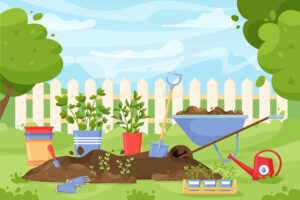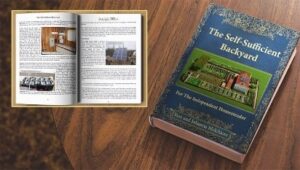
Permaculture principle 9 is a principle of permaculture design that encourages us to start small, take it slow, and think sustainably. This is an approach that seeks to build resilience in our ecosystems through gradual development over long-term periods. It emphasizes the importance of mindfully managing resources for sustainable outcomes. In this article, we will discuss what this principle is and its significance in permaculture design, implementation examples, the benefits of small and slow solutions, and potential challenges when implementing them, and conclude with a summary of the role they play in building sustainable systems.
Understanding the concept of ‘small and slow solutions’
The phrase ‘small and slow solutions’ refers to incremental changes that are taken over long-term periods to achieve a desired result. It is an approach to permaculture design that emphasizes the importance of patience and mindful resource management for sustainable outcomes to be achieved. This principle is based on the idea that small, regular efforts can go a long way in terms of creating resilient ecosystems. It encourages us to start small and take incremental steps towards our ultimate goal, rather than attempting large-scale solutions that may not be feasible or sustainable.
The importance of ‘small and slow solutions
Small and slow solutions are an important part of permaculture design because they can help us achieve sustainable outcomes more efficiently and effectively. They emphasize the importance of patience, mindful resource management, and gradual development over a long-term period. This approach helps to ensure that our resources are better managed and that we’re able to build resilience in our ecosystems over time. Additionally, it also has the potential to create positive ripple effects in terms of both environmental and social outcomes.
Implementation Examples
Rainwater harvesting
Rainwater harvesting is an example of a small and slow solution that can be implemented as part of permaculture design. This practice involves collecting and storing rainwater in tanks or other containers, which can then be used for various purposes such as irrigation, cleaning, and drinking water. By taking small steps such as collecting and storing rainwater, we can make use of a valuable resource in an efficient and sustainable way.
Composting
Composting is another example of a small and slow solution that can be implemented within permaculture design. This process involves breaking down organic material into compost, which can then be used as a nutrient-rich soil amendment for plants. Composting helps to reduce the amount of waste that is sent to landfills and provides an additional source of nutrients for growing food sustainably. Additionally, it also encourages biodiversity by helping to create healthy soils that support a variety of organisms.
Homemade Vinegar
Homemade vinegar is an example of how small and slow solutions can be used to create something useful. Vinegar is easy to make and requires minimal equipment, making it an ideal solution for those looking to save time and money when shopping for ingredients. Making vinegar also allows us to control the quality of the product, ensuring that only high-quality ingredients are used in its production. In addition, making vinegar at home is a great way to reduce the amount of packaging associated with store-bought products, minimize food waste, and contribute to an overall sustainable lifestyle.
Kitchen Gardens
Kitchen gardens are another example of how small and slow solutions can help us live more sustainably. Planting a kitchen garden allows us to grow our own food, reducing the need for store-bought produce. It also helps reduce food waste by allowing us to harvest only what we need and compost any excess material. Additionally, kitchen gardens provide an additional source of beauty and aesthetics in our homes and can be tailored to individual tastes. As a bonus, growing our own food often saves money in the long run and provides us with a sense of accomplishment.
Repurposing Used Items
Repurposing used items is another great way to live more sustainably. Rather than throwing away unwanted pieces, we can find creative ways to upcycle them, giving them a new life in the form of furniture, decor, or even art. Repurposing used items can also help reduce the amount of waste produced and save money in the long run. In addition, it gives us a unique opportunity to be creative and design something truly special from scratch.
Upcycling Clothing
Upcycling clothing is an increasingly popular trend that enables us to give old clothes new life rather than throwing them away. We can do this by altering or mending clothes to make them fit better, creating new, unique pieces from old ones, or even upcycling to create something completely new. Upcycling not only reduces the amount of clothing waste produced but also allows us to express our style and creativity. Additionally, it often saves money in the long run and gives us a sense of accomplishment.
Growing Herbs Indoors
Growing herbs indoors is another great way to live more sustainably while adding flavor to our meals at the same time. All we need is some soil, some basic gardening tools, and a few herbs of our choice. Growing herbs indoors helps reduce the amount of waste produced while also giving us fresh ingredients for cooking. Additionally, it allows us to practice gardening and get creative with different combinations of flavors and aromas.
Making Homemade Soap
Making homemade soap is yet another great way to reduce waste and save money. It also allows us to choose the ingredients we want to use, such as essential oils for fragrance or natural ingredients like herbs and flowers for color. Making homemade soap is a fun activity that can be enjoyed by all ages, and it’s surprisingly easy with just a few simple steps. Not only does making homemade soap help reduce waste, but it also brings us closer to nature and helps us be more mindful of our decisions.
Benefits of Small and Slow Solutions
When it comes to living a more sustainable life, small and slow solutions are often the best way to go. They take less effort and money than larger projects but still make a big impact on our environment. Small and slow solutions can also bring communities together in ways that bigger projects sometimes can’t.
One of the biggest benefits of small and slow solutions is that they often require fewer resources. This means we can spend less money on things like materials, energy, or labor while still achieving our goals. Additionally, these solutions are much more accessible to people with limited resources. This makes it easier for everyone to make a difference in their own lives without having to sacrifice too much.
Finally, small and slow solutions allow us to be more mindful of our decisions and the impact they have on the environment. It encourages us to think about our choices carefully so that we can make the most sustainable decision possible. This helps us stay on track with our long-term goals and make sure we’re doing everything we can to preserve the earth for future generations.
Challenges in Implementing Small and Slow Solutions
Despite the compelling benefits of small and slow solutions, their implementation is not without challenges. One major hurdle lies in the mindset of instant gratification prevalent in today’s society. The notion of “bigger, better, faster” often overshadows the sustainable approach of smaller, slower progression, causing people to overlook their long-term benefits.
Another challenge pertains to the lack of awareness and understanding. The concept of small and slow solutions is not universally understood or accepted, leading to misinformation and doubts about their effectiveness.
A further obstacle is the perceived lack of immediate, tangible results. Since the impact of these solutions is often seen over a prolonged period, it can discourage those who seek instant outcomes, thereby hindering the widespread adoption of these strategies.
Finally, in an economy driven by consumption, implementing small and slow solutions can be challenging. Systems and infrastructures are primarily designed to support and encourage rapid consumption and not slow, sustainable practices. Despite these challenges, the adoption and promotion of small and slow solutions remain vital for a sustainable future.
Conclusion
In conclusion, the adoption of small and slow solutions is an essential pathway towards achieving sustainability. Despite the challenges associated with their implementation, such as the societal mindset of instant gratification, lack of awareness, and the current consumption-driven economy, these strategies offer a sustainable and resilient approach for our future. By shifting our focus to slow, steady progression, and by increasing our understanding and promotion of these practices, we can reshape our society and economy to be more sustainable. This transition will not only benefit us but also ensure a healthier and more sustainable world for future generations.
For more permaculture principles click here.

